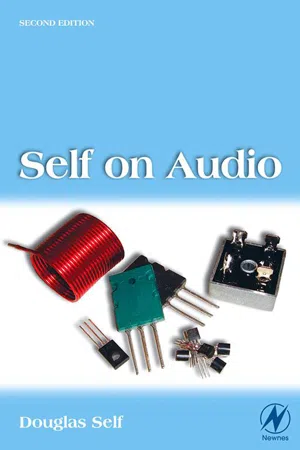![]()
![]()
14
Sound mosfet design
This was the first article on power amplifiers that I wrote, though I had been designing them for manufacture since 1975. This investigation into the concept of combining power FET output devices with bipolar drivers was done some years before I undertook my major investigation into the root causes of power amplifier distortion. (See Distortion in Power Amplifiers, Parts 1–8, later in this book.) In the throes of the design process, I realised with greater force than hitherto that the distortions in the small-signal part of a power amplifier were (a) far from negligible and (b) susceptible to analysis by a mixture of SPICE simulation and a few well-chosen experiments. I also determined that SPICE could be extremely useful in the analysis of output stages. The rest is history.
I have resisted the temptation to edit the text in the light of later knowledge, as this would, I think, be cheating. To prevent people being misled, I will just point out that the final circuit falls somewhat short of the Blameless performance standards set by the Distortion in Power Amplifiers series. The input stage may look symmetrical, but in fact is grotesquely unbalanced, with 16 μA flowing through the left transistor of the pair, and 580 μA through the right. This stage must have generated far more second-harmonic distortion than necessary, and with the benefit of hindsight I am not very proud of it. This imbalance also means that the input stage transconductance is far too low, which precludes any emitter degeneration of the input pair, and this also explains why a dominant-pole capacitor as small as 15 pF is enough for stability. The voltage-amplifier stage could be improved in linearity by adding another transistor within the Cdom local feedback loop.
Mosfet amplifiers undoubtedly present a tantalising prospect for simple circuitry. Unfortunately, practical application requires careful consideration of their many foibles. But my aim here is to stimulate thinking about possible improvements to FET power amps, and describe two new avenues of development. Each produces a practical result, though neither should be regarded as a foolproof recipe for success.
Power-amplifier design is as prone as any other branch of audio to folklore and confusion. One of the less extreme myths holds that high levels of negative feedback are ‘A Bad Thing’ because they require heavier compensation for HF stability, leading to low slew rates and generally indolent and sluggish behaviour.
As far as it goes this is true. But only a poor designer would lose all sight of slew rate while adjusting amplifier compensation. Despite much study of TIM, DIM, SID, ‘internal overload’, ‘delayed feedback’ and the rest, everything comes back to slew rate.
If an amplifier can reproduce a 20 kHz sine wave at full amplitude without excessive distortion (say under 0.1%) it can be regarded as blameless in respect of speed. Apply as much feedback as is decent, but always keep an eye on stability and slew rate.
Design fundamentals
Ground rules for this design study require DC output coupling, one preset only (for quiescent current) and as simple a circuit as possible.
In the current audio market, almost any technological approach appears to be acceptable (an idiosyncratic hybrid with valves driving power fets is one recent design,1) with the possible exception of capacitor output coupling.
While problems can include capacitor distortion at LF (of the real and measurable kind2) and perhaps grounding difficulties, the overwhelming simplicity of this method still has its attractions; the almost unnatural reliability of the capacitor-coupled Quad 303 should be mentioned at this point.
But a designer must still prove that he knows what a differential pair is, and d.c. coupling has therefore been adopted. However, remember that proper offset protection is not a trivial problem, as the cost of a reliable output relay and d.c. detection circuitry can add 30% to amplifier electronics costs. A relay seems unavoidable, as my own experiences with kamikaze crowbars have been distinctly unhappy, though I would not claim this to be a definitive judgment.
So a simple unregulated power supply looks to be the best. I realise this brings me into head-to-head confrontation with Mr Linsley Hood,3 so I shall quickly explain my preference.
Putting expensive power semiconductors in a high-current dual supply can easily double an amplifier’s electronic-component cost and there is much more to go wrong.
Ensuring PSU HF stability can be difficult, and the PSU compensation required, threatening a steadily rising output impedance versus frequency, can lead to some awkward amplifier stability problems.
Finally, the unregulated supply can deliver more power on a transient basis – which is exactly what is required for audio.
The price to be paid for unregulated simplicity is the attention to be paid to the amplifier’s supply-rail rejection. But since it is physically impossible for the voltage on large reservoir capacitors to change very quickly, this rejection need only be extremely good at low frequencies.
The excellent supply-rail rejection of IC op-amps – and a power amplifier is, after all, only a big op-amp – shows the problem to be distinctly soluble, although I admit that op-amp PSRR often differs markedly between the two rails, and usually declines above 1 kHz. This sort of difficulty can be simply solved in a power amplifier with a little RC decoupling.
Harmonic distortion should be kept as low as possible, but without spending significant money specifically on its reduction. THD in commercial equipment varies more widely than any other performance parameter, ranging from 0.003% to 1% at similar powers4 with the most expensive units often giving the worst performance.
In marketing circles, there are clearly two routes to take: make the THD vanishingly small to show you know what you’re doing; or make it poor and imply that this very practical parameter has been sacrificed in favour of some intangible and unmeasurable sonic benefit.
I have always gone for the form...
